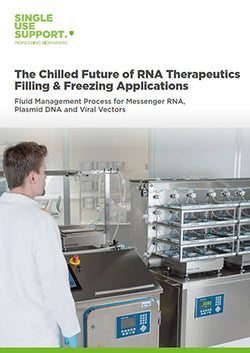Pros & Cons of lipid nanoparticles for mRNA delivery
Lipid nanoparticles is about to change the pharmaceutical industry in their role as very efficient drug delivery systems, but shown advantages to different fields, like cosmetics, agriculture and other areas. Even though they are already successfully used for vaccines like the Covid-19 mRNA vaccines, their potential for many pharmaceuticals is yet to unfold with new developments in regards to research, manufacturing and storage.
In the following, we will provide a definition of LNPs, take a look at their structure, their potential and the challenges related to them.[[1]]
Lipid nanoparticles – a brief definition
Lipid nanoparticles (LNPs) are defined as nanoparticles that consist of lipids. Those lipids can be both liquid and solid and are stabilized by emulsifiers. Lipids used for lipid nanoparticle formulations range from water soluble and liposoluble ingredients like phospholipids, cholesterol, polyethylene glycol or PEGylated lipids and ionized, catatonic lipids. Once the ratio between these lipids is established, lipid nanoparticles are able to enclose drug molecules and transport them safely to the specific cell lines for transfection. Due to their particle size and other qualities, LNPs show great potential as drug delivery systems in the treatment of cancers and other diseases.
There are different kinds of lipid nanoparticles, namely nanostructured lipid carriers and solid lipid nanoparticles. Nanostructured lipid carriers are often described as the next generation of LNPs.[[2]] [[3]]
Types and applications of lipid nanoparticles
There are different types of lipid nanoparticles with a high significance to different fields, including pharmaceutics, cosmetics and food production.
LNPs contain solid and liquid lipids such as phospholipids, cholesterol, polymers like PEGylated lipids and ionized, catatonic lipids, as well as emulsifiers. Once a stable formulation between liposoluble and water-soluble lipids is established, the lipid nanoparticle formulation can be used for the delivery of messenger RNA, oligonucleotides, siRNA or cytotoxic drugs used in cancer immunotherapy to the cytosol of dendritic cells. In the past, cationic lipids, ionizable lipids and other types of lipids have shown good results as mRNA delivery agents.
Through this synthesis with the helper lipid that functions as a non-viral vector, the genetic material or nucleic acid is delivered to the targeted cells where it is absorbed.
The two major types of LNPs are solid lipid nanoparticles and nanostructured lipid carriers.
Solid lipid nanoparticles (SLNs) have a core matrix which consists of solid lipids and stabilizing emulsifiers.
The core matrix of nanostructured lipid carriers (NLCs) consists of solid and liquid lipids. Compared to conventional drug delivery systems, they show advantages in terms of solubility, stability, bioavailability, reduced side effects, reduced drug leakage, prolonged half-life and advanced tissue targeting qualities. They do not only hold high potential as drug delivery systems, but also cosmetics as ingredients in skincare products.[[4]] [[5]]
Where are LNPs used?
- Drug delivery in cancer therapy
- Antibacterial agent in the treatment of fungal infections
- Carrier for nucleic acid drugs in gene therapy
- Non-viral vector in Covid-19 mRNA vaccines
Nanostructured lipid carriers for mRNA
The latest successful example for lipid nanoparticle formulations in immunogenicity is the use of nanostructured lipid carriers in mRNA vaccines, such as Covid-19 vaccines to induce antibody-mediated cytokine expression. Nanostructured lipid carriers show good responses to changes in temperature, which can pose a challenge when working with LNPs as carrier systems and affect biodistribution. To prepare lipids for the mixture, they are first dissolved in ethanol and mixed with water to ensure ideal distribution in the soluble.
In the case of the Covid-19 vaccines, NLCs are used as adjuvant lipids and act as an encapsulation of the transcription RNA encoding the antimicrobial peptide SARS-COV-2 spike protein. As soon as the intracellular RNA delivery to the cytoplasm of the targeted cell is completed, the antigen triggers an immune response to the virus and leads the immune cells to produce a specific antibody. One method to prove if the NLCs have delivered the mRNA successfully is using fluorescent dyes as labels for monitoring and modulation.

Due to their beneficial qualities, many nanostructured lipid carriers are currently in clinical trials or awaiting approval from the FDA.
Pros of lipid nanoparticles in mRNA delivery
The use of lipid nanoparticles for the delivery of mRNA in LNP formulation shows many advantages. With research and manufacturing development in progress, concerns for their use in mRNA therapeutics like cellular uptake and biodistribution rates will eventually be increased.
No bio-toxicity
As LNPs are made from biodegradable and biocompatible materials, they show no bio-toxicity.
High physical stability
LNPs show a highly stable structure when kept at body temperature, as well as when undergoing specialized manufacturing and freezing processes.
Targeting qualities
mRNA-LNPs are used as delivery agents encapsulating lipophilic as well as hydrophilic medication because of their high targeting qualities through ligand functionalization. They are able to protect RNA from degradation in the bloodstream and bind to specific receptors on cell membranes.
Cons of lipid nanoparticles in mRNA delivery
Lipid nanoparticles have a high potential to change the future of mRNA delivery. Still, as they are a relatively new substance, with the first FDA-approved siRNA drug in 2018, there are certain issues that require optimization. Especially the demand for more research regarding lipid nanoparticles toxicity is a barrier that has to be approached in order to guarantee safe use and protection for patients, staff and environment.
In the following, we have listed some of the current disadvantages of lipid nanoparticles in mRNA delivery.
Low drug load efficiency
Currently, most LNPs have a comparably low drug load efficiency. This problem is currently approached via new synthesizing strategies.[[6]]
Instability in vivo
Due to their relatively short half-life, LNPs can show instability under in vivo conditions. Endosomal escape and removal through macrophages of lipid nanoparticles is possible without proper cellular uptake.
Short blood circulation time
Even though nanoparticles can be selective for specific cell types, it can happen that, once they enter the blood circulation, they get attacked by T cells and thereby removed from the system.
Stability
Especially for storage (aqueous, freezing or lyophilized) and transport of nanomedicine, maintaining LNP stability and reproducibility can be a challenge. They are prone to contamination and very responsive to changes in pH, enzymes and light and have to be kept under the right conditions to prevent crystallization and decrease in particles.
Toxicity concerns
Research, characterization of synthesized lipids and further clinical trials are needed to find out more about the possible toxicity in regards to manufacturing and environment of LNPs that are yet to enter the market. Still, assays remain a challenge because in vitro conditions often do not match in vivo circumstances due to particle size and ratios.
Facing challenges regarding lipid nanoparticles with single-use technology
The future of lipid nanoparticles remains an exciting prospect. To face the challenges associated with handling lipid nanoparticles during manufacturing and storage, Single Use Support has developed fully automated end-to-end solutions that minimize contamination risks and allow for freezing LNPs for long-term stability.

Through filling and aliquoting LNPs in single-use bags, unwanted effects like crystallization, which could cause damage to the product, can be avoided by controlled filling, freezing and thawing methods.
Furthermore, elaborate freezing platforms based on plate freezing allow for controlled and fast freezing of LNP-based products at lab and bulk scale, keeping them viable for the moment of their application.
- Lipid nanoparticles for mRNA delivery, http://dx.doi.org/10.1038/s41578-021-00358-0, Published 2021-08-10
- Deconvoluting Lipid Nanoparticle Structure for Messenger RNA Delivery, http://dx.doi.org/10.1021/acs.nanolett.0c01386, Published 2020-05-06
- Solid Lipid Nanoparticles and Nanostructured Lipid Carriers: Structure, Preparation and Application, http://dx.doi.org/10.15171/apb.2015.043, Published 2015-09-28
- A flexible, thermostable nanostructured lipid carrier platform for RNA vaccine delivery, http://dx.doi.org/10.1016/j.omtm.2022.03.009, Published 2022-03-16
- Fang, Chia-Lang et al. “Nanostructured lipid carriers (NLCs) for drug delivery and targeting.”, https://pubmed.ncbi.nlm.nih.gov/22946628/, Published 2013
- Development of High‐Drug‐Loading Nanoparticles, http://dx.doi.org/10.1002/cplu.202000496, Published 2020-08-10

Download now
App Note: The Chilled Future of RNA Therapeutics Filling & Freezing Applications
This application note explores scalable, GMP-compatible solutions for the sterile filling and cryopreservation of mRNA, pDNA, and viral vectors. It presents modular technologies that ensure temperature control, minimize product loss, and support high-accuracy aliquotation - paving the way for efficient commercialization of RNA-based therapeutics.

